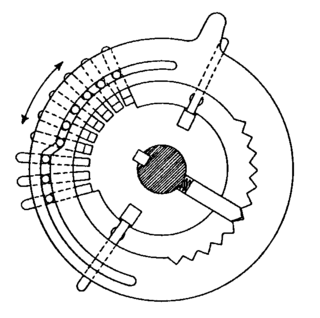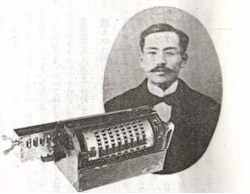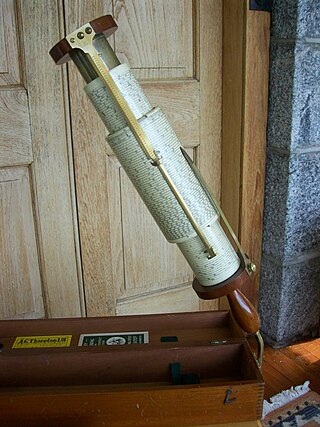History
The Curta was conceived by Curt Herzstark in the 1930s in Vienna, Austria. By 1938, he had filed a key patent, covering his complemented stepped drum. [3] [4] This single drum replaced the multiple drums, typically around 10 or so, of contemporary calculators, and it enabled not only addition, but subtraction through nines complement math, essentially subtracting by adding. The nines' complement math breakthrough eliminated the significant mechanical complexity created when "borrowing" during subtraction. This drum was the key to miniaturizing the Curta.
His work on the pocket calculator stopped in 1938 when the Nazis forced him and his company to concentrate on manufacturing precision instruments for the German army. [5]
Herzstark, the son of a Catholic mother and Jewish father, was taken into custody in 1943 and eventually sent to Buchenwald concentration camp, where he was encouraged to continue his earlier research:
While I was imprisoned inside Buchenwald I had, after a few days, told the [people] in the work production scheduling department of my ideas. The head of the department, Mr. Munich said, 'See, Herzstark, I understand you've been working on a new thing, a small calculating machine. Do you know, I can give you a tip. We will allow you to make and draw everything. If it is really worth something, then we will give it to the Führer as a present after we win the war. Then, surely, you will be made an Aryan.' For me, that was the first time I thought to myself, my God, if you do this, you can extend your life. And then and there I started to draw the CURTA, the way I had imagined it.
—
Curt Herzstark, Oral history interview with Curt Herzstark (1987), pp. 36-37 [6]
In the camp, Herzstark was able to develop working drawings for a manufacturable device. Buchenwald was liberated by U.S. troops on 11 April 1945, and by November Herzstark had located a factory in Sommertal, near Weimar, whose machinists were skilled enough to produce three working prototypes. [6]
Soviet forces had arrived in July, and Herzstark feared being sent to Russia, so, later that same month, he fled to Austria. He began to look for financial backers, at the same time filing continuing patents as well as several additional patents to protect his work. Franz Joseph II, Prince of Liechtenstein eventually showed interest in the manufacture of the device, and soon a newly formed company, Contina AG Mauren, began production in Liechtenstein.
It was not long before Herzstark's financial backers, thinking they had got from him all they needed, conspired to force him out by reducing the value of all of the company's existing stock to zero, including his one-third interest. [1] These were the same people who had earlier elected not to have Herzstark transfer ownership of his patents to the company, so that, should anyone sue, they would be suing Herzstark, not the company, thereby protecting themselves at Herzstark's expense. This ploy now backfired: without the patent rights, they could manufacture nothing. Herzstark was able to negotiate a new agreement, and money continued to flow to him.
Curtas were considered the best portable calculators available until they were displaced by electronic calculators in the 1970s. [1] The Curta, however, lives on, being a highly popular collectible, with thousands of machines working just as smoothly as they did at the time of their manufacture. [1] [6] [7]
An estimated 140,000 Curta calculators were made (80,000 Type I and 60,000 Type II). According to Curt Herzstark, the last Curta was produced in 1972. [6]
Cost
The Curta Type I was sold for $125 in the later years of production, and the Type II was sold for $175. While only 3% of Curtas were returned to the factory for warranty repair, [6] a small, but significant number of buyers returned their Curtas in pieces, having attempted to disassemble them. Reassembling the machine was more difficult, requiring intimate knowledge of the orientation of, and installation order for, each part and sub-assembly, plus special guides designed to hold the pieces in place during assembly. Many identical-looking parts, each with slightly different dimensions, required test fitting and selection as well as special tools to adjust to design tolerances. [8]
The machines have a high curiosity value; in 2016 they sold for around US$1,000, but buyers paid as much as US$1,900 for models in pristine condition with notable serial numbers. [5]

























